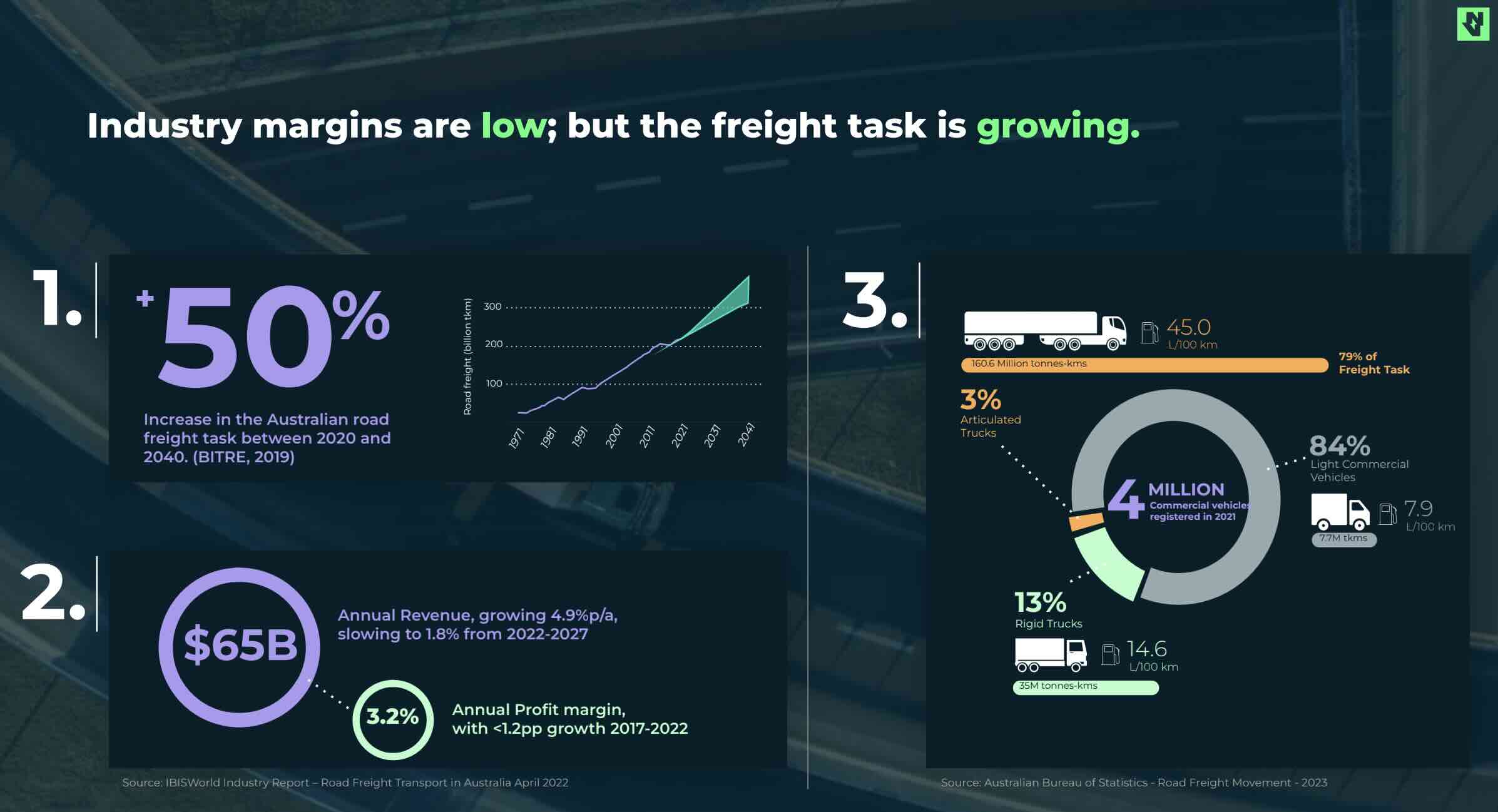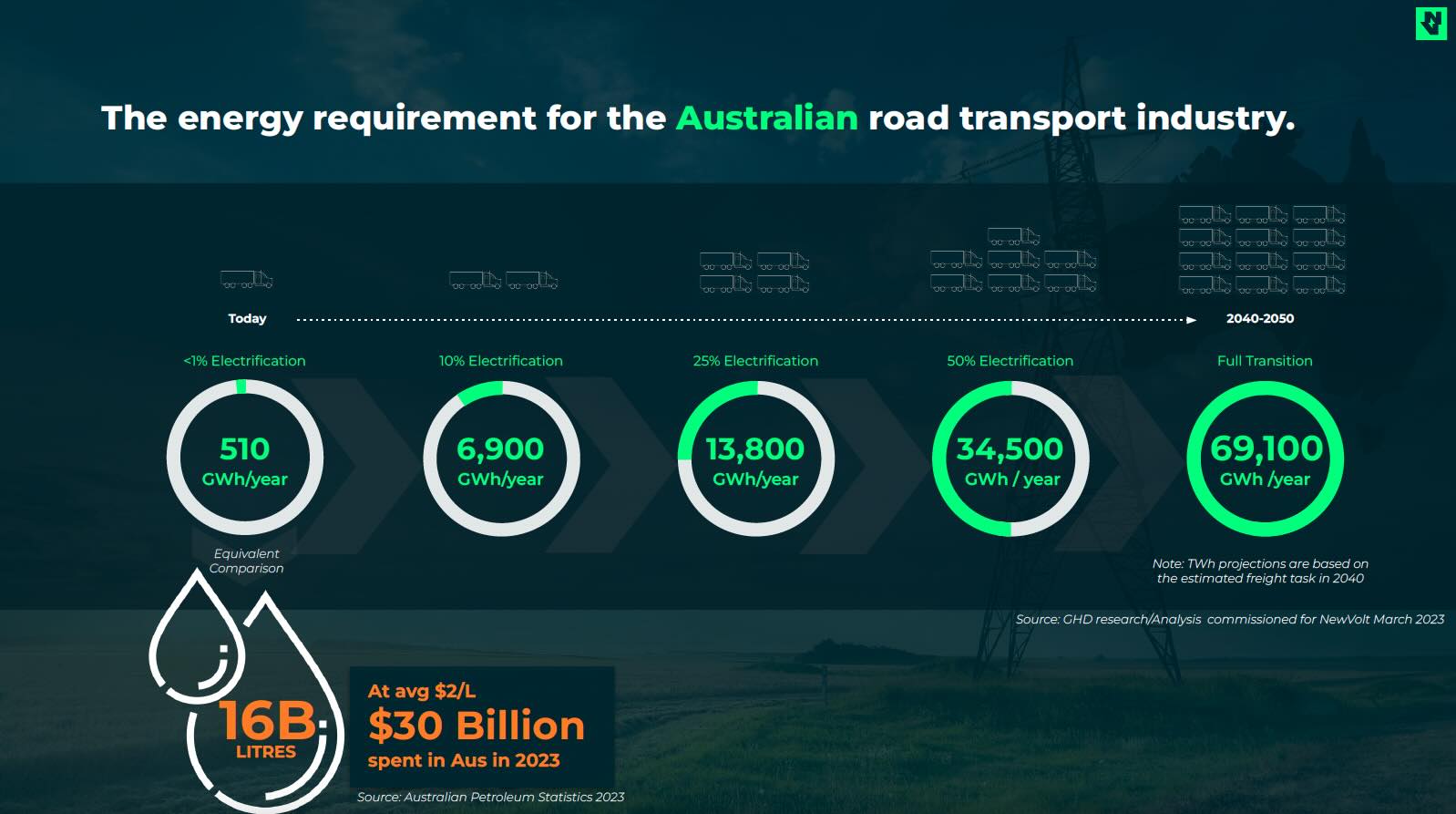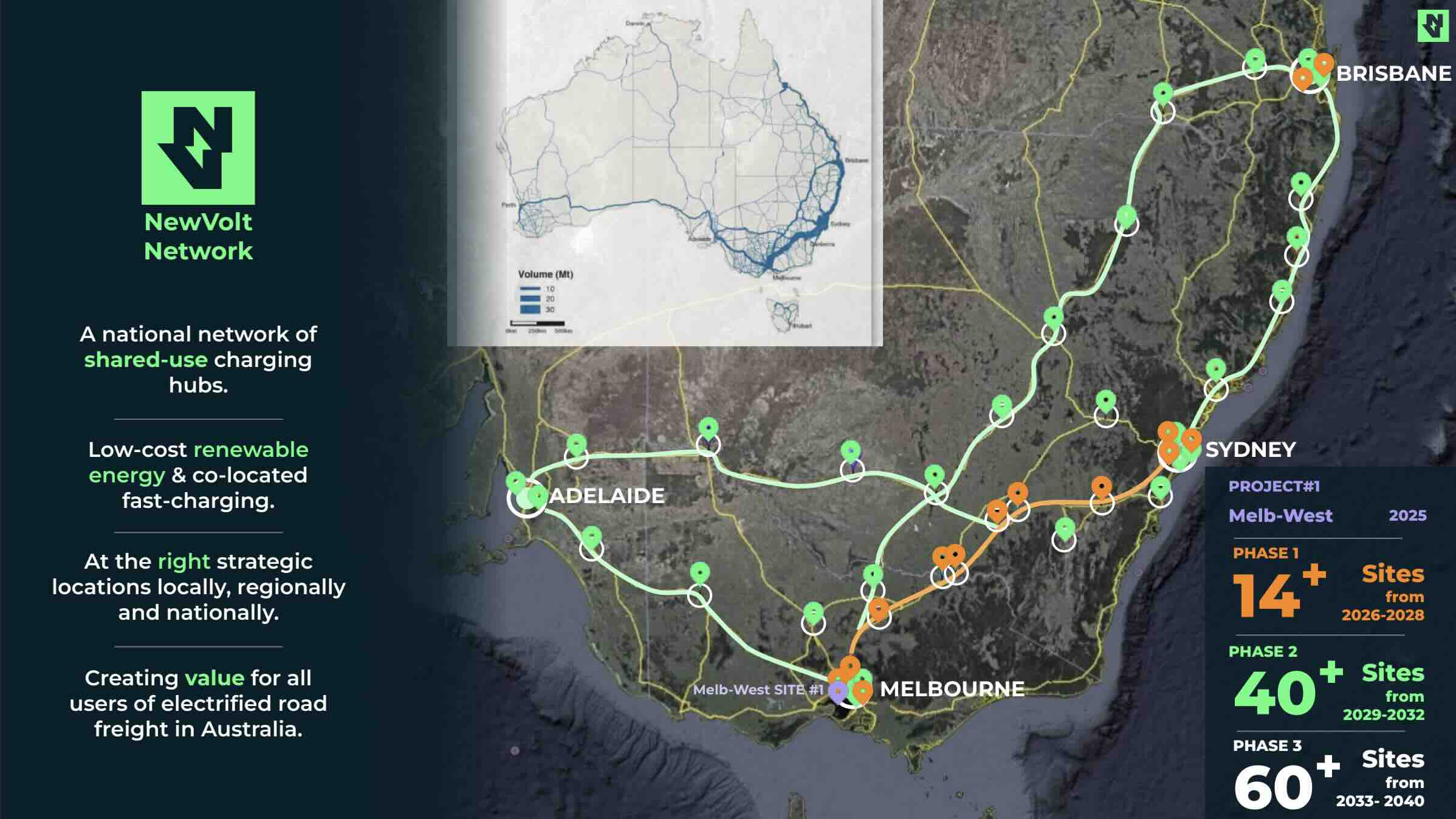Revolutionising the truck stop: NewVolt unveils plans for charging network to electrify Australia’s road freight
Australian start-up NewVolt[1] has revealed plans to build an electric truck charging network along the east coast of Australia, enabling the decarbonisation of the country’s major road freight routes and potentially saving billions of dollars spent on imported diesel a year.
NewVolt plans to have its first truck charging station up and running in Melbourne in 2025, followed by another 14 sites in key precincts in Melbourne, Sydney, Brisbane and the Hume Highway from 2027, and then a 40 site metropolitan expansion, with the Pacific, Newell, Sturt & Western Highway connections anticipated from 2030.
The sites will be fully powered by renewable energy with regional truck stops tapping into their own locally produced solar power. The sites will also include a driver lounge, access to office space, wifi and amenities.
“Australia needs to be fully charged and ready for electrified freight,” said Andy Evans, chairman and co-founder of NewVolt.
“The NewVolt Network is designed to provide Australia with a pathway to decarbonise road freight by delivering price-certain, reliable, renewable energy through a national network of shared charging infrastructure.”
Evans is the former CEO and cofounder of the Star of the South offshore wind farm and has worked on a number of renewable energy projects over the past two decades. Together with co-founders, Anthony Headlam and Rainer Knobloch, NewVolt has put together an impressive team including experts from the transport, infrastructure and renewable energy sectors.
NewVolt CEO Anthony Headlam, who previously worked with Danish wind energy giant Vestas, sees a huge opportunity for the first mover in Australia.
“Electrification is coming, and shared-use charging is central to achieving the scale needed to support a connected network for heavy vehicles,” said Headlam.
Electrifying fleets is a rational choice for trucking industry
Unlike the consumer vehicle market, in which car makers use advertising to tap into customers’ emotions to sell their vehicles, trucking is just about the numbers. And the numbers for electrifying road freight are very compelling, with the potential to save the trucking industry billions of dollars per year.
“NewVolt are designing our network to leverage on-site energy generation where possible in order to deliver the lowest levelised cost of charging (LCOC). By taking advantage of Australia’s ability to generate low cost renewable energy, we believe the total cost of ownership (TCO) benefits of electric trucks in Australia will be very compelling”, says Rainer Knobloch Co-Founder, NewVolt.


With current renewables prices already putting electric trucks ahead, the business case becomes even stronger as solar and wind energy continue along their declining cost curves in coming years.
As renewables decline in costs, high volatility in the global oil market due to the war in Ukraine and unrest in the Middle East could see diesel prices moving in the opposite direction.
NewVolt is collaborating with truck manufacturers to offer long term contracts with fixed charging fees to give trucking operators the confidence to make the switch and start reaping the benefits.
The company says that Australia consumed around 16 billion litres of diesel in 2023, costing the country around $30 billion. Based on their projections, which include 50% growth in road freight by 2040, NewVolt says the electrification of the entire trucking industry would require around 70,000 GWh of renewable energy per year.


Electrifying trucks is a game changer for energy security
Currently 91% of Australia’s diesel is imported. NewVolt says in addition to the significant cost savings, the electrification of the trucking fleet will have a game changing impact on Australia’s energy security.
The fuel price spikes resulting from Russia’s invasion of Ukraine highlight how geopolitical instability has a huge impact on global freight prices, driving cost inflation at every part of every supply chain.
With the potential for conflict now spreading in the middle east, including to high oil producing nations, threats to Australia’s fossil fuelled freight system are increasing, and fuel companies know this. At Ampol’s investor call earlier this week, CEO Matt Halliday said geopolitical disruption is likely to continue.
The health and cost benefits of removing diesel trucks from ports and railyards
Some governments are already moving aggressively on electrifying trucks[2]. Last year the California Air Resources Board (CARB) approved its Advanced Clean Fleets[3] rule which requires all new medium and heavy-duty vehicles sold or registered in California to be zero-emission by 2036.
The new law also bans new diesel trucks, made from 2024 onwards, from Californian ports and railyards from January 1 2024.
CARB estimates the new regulations will save $US26.5 billion in statewide health benefits from reduced pollutant emissions as well as net cost savings of $48 billion for trucking fleets.
NewVolt says an average of 11,000 diesel trucks pass by residents of Port of Melbourne and adjacent suburbs each day resulting in adolescent asthma rates that are 50% above the Victorian state average.
And it’s in this area where the company plans to build its first electric “hub & spoke” charging site, in collaboration with Mondo Clean Mobility (a subsidiary of AusNet) to cater for local freight routes before building “enroute” sites linking Melbourne, Sydney and Brisbane.
The electrification of trucks will also bring enormous health and well-being benefits to around 200,000 truck drivers in Australia.
Last year a study in Canada[4] found that diesel pollution can dull the human brain in hours. Another study by Melbourne University[5] found vehicle pollution in Australia causes 11,000 premature deaths and is responsible for over 12,000 cardiovascular hospitalisations, 66,000 active asthma cases, and almost 7,000 respiratory hospitalisations per year.
And it’s not just air pollution. New research has shown devastating health impacts from petrol and diesel traffic noise. A landmark study[6] in March last year found increased levels of hypertension and cardiovascular disease in people who are exposed to high levels of traffic noise. Noise that will be significantly reduced with the transition to electric trucks.
The health benefits of electric trucks for road transport workers was recently discussed by panelists at Everything Electric[7].
“Road transport workers are now able to get home at the end of the day and actually have a life because they’re not exhausted from the effects of spending time on the road. It is amazing the difference it makes to their lifestyle.” said Marc Sibbald, editor of of Fleet EV News.[8]
Truck-to-grid. Converging technologies set to usher in a new era
Yet another exciting possibility for electrifying trucks is the prospect of truck-to-grid (T2G) bi-directional charging.
While truck charging can be timed to coincide with low price periods, like during daily solar peaks, vehicle-to-grid capability would enable idle electric trucks to sell electricity back to the grid during peak demand times providing an additional potential revenue stream for trucking companies.
The massive opportunities for bi-directional charging were highlighted last week after storms cut transmission lines in Victoria, leaving 500,000 households without power and spiking the electricity wholesale price to a staggering $16,600 per MWh. Households who had home batteries and wholesale export tariff deals with their energy providers, actually profited off the situation[9] by selling electricity back into the grid at the highly elevated price.
The convergence of the million mile battery, new vehicle-to-grid tariffs[10] and software platforms offering realtime wholesale electricity trading, is pointing towards a future where transport and energy become highly integrated, highly intelligent and highly efficient.
To get a sense of the scale, 200,000 trucks each with a 400kWh battery effectively represents 80GWh of mobile battery storage. In contrast, the largest stationary battery project in Australia is the 2.4 GWh battery at Melbourne Renewable Energy Hub[11].
A future where thousands of electric trucks not only charge from renewable energy but also respond to wholesale electricity price signals and provide grid load management through bi-directional charging is a very exciting prospect that could significantly accelerate the transition to a pollution free world.
If successful, NewVolt’s truck charging network could support cheaper freight and higher margins for trucking companies while simultaneously reducing pollution and improving the lives of thousands of road transport workers and millions of other Australians.


Daniel Bleakley is a clean technology researcher and advocate with a background in engineering and business. He has a strong interest in electric vehicles, renewable energy, manufacturing and public policy.
References
- ^ Australian start-up NewVolt (www.newvolt.com.au)
- ^ moving aggressively on electrifying trucks (thedriven.io)
- ^ Advanced Clean Fleets (ww2.arb.ca.gov)
- ^ study in Canada (thedriven.io)
- ^ Another study by Melbourne University (thedriven.io)
- ^ A landmark study (thedriven.io)
- ^ recently discussed by panelists at Everything Electric (thedriven.io)
- ^ Fleet EV News. (fleetevnews.com.au)
- ^ profited off the situation (thedriven.io)
- ^ vehicle-to-grid tariffs (thedriven.io)
- ^ Melbourne Renewable Energy Hub (reneweconomy.com.au)
